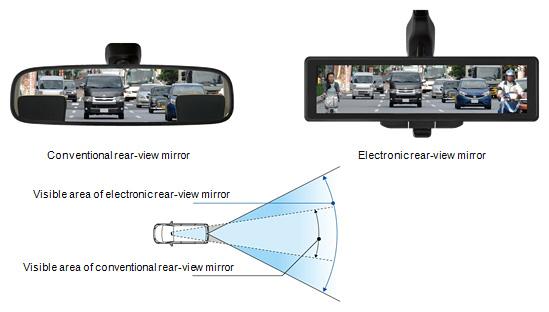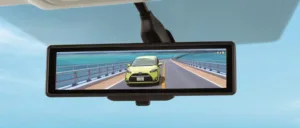Panasonic said that it is to start making electronic rear view mirrors, the first product jointly developed with Ficosa which Panasonic took a 60% share in earlier this year (CE Firms Look into Automotive) and then made a consolidated subsidiary.
The electronic rear-view mirror uses a camera with a wide-angle lens that captures a wide rearward area, offering a wider viewing angle than conventional rear-view mirrors. By installing the camera inside on the rear window, this mirror provides a safer and clearer rearward view that is not obstructed by rear-seat passengers.
1. The wide-angle lens camera provides a wide rearward field of vision and improves visibility.
Using a wide-angle lens camera, the electronic rear-view mirror shows a wider rearward area at a longer distance (horizontal direction) behind the vehicle and improves visibility of hard-to-see areas diagonally behind the vehicle, compared to conventional rear-view mirrors.
(Even electronic rear-view mirrors have blind spots.)

2. The camera installed on the rear window is not obstructed by rear-seat passengers, and reduces blind spots.
By installing the camera inside on the rear window, the electronic rear-view mirror reduces rear blind spots. Unlike conventional rear-view mirrors, this rear-view mirror provides a rearward view, fed by the camera, unobstructed by rear-seat passengers or objects present in the vehicle.

3. The high-sensitivity camera provides a clear view at night or in a tunnel.
The camera with high-sensitivity obtains clear images during nighttime driving or when driving through a tunnel. The camera switches to the nighttime mode in conjunction with the headlight switch and reduces headlight glare seen when using conventional rear-view mirrors.

(Panasonic said that images are for illustrative purposes only; views using the actual product may vary. Pictures are simulations only.)

